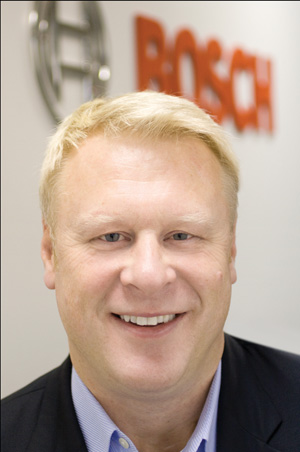Are rising costs a significant matter for Bosch? If so, which cause you the most concern?
Joergenrud: We are seeing significant increases across most product categories. For example, from January 2009 through April 2011, commodity prices have increased as follows: Steel +166 percent, copper +300 percent, oil +150 percent, lead +230 percent, rubber +266 percent and platinum +80 percent.
Cost control is important to us because it is important to our customers in keeping them competitive. Our two biggest cost concerns deal with raw materials and fuel for transport. We’re not alone in this. According to a study just released by Automotive Aftermarket Suppliers Association (AASA), some 97 percent of suppliers report significant economic impact from higher fuel prices in the last year. So all suppliers, in our industry and others, are facing similar challenges in terms of material costs and transportation.
 How does Bosch deal with suppliers when advised of price increases for raw materials?
How does Bosch deal with suppliers when advised of price increases for raw materials?
Joergenrud: We have a variety of tools at our disposal. Since Bosch is a very large global company, we have great purchasing power and business relationships to source materials all over the globe. We are strengthening this position by setting up a global, cross-divisional purchasing organization for purchased raw materials and other inputs. Of course, all suppliers must meet our very stringent standards.
How does Bosch’s stature as one of the largest global automotive suppliers impact your cost structure?
Joergenrud: We are fortunate to supply products globally to the OEs and the automotive aftermarket. By supporting both markets, we have purchasing power that allows us to source at the lowest possible costs.
Do you expect to pass along increased costs to your customers as price increases in the near-term future?
Joergenrud: We will certainly exhaust all options available to us before implementing price increases, minimizing them to the greatest extent possible in order to keep our distributor and retailer customers competitive. To the extent we cannot off-set those increases, we will need to take the corresponding pricing actions.
What can you do to minimize the impact of any such price increases on your customers?
Joergenrud: Actually, there is much we have done and much we can continue to do to enhance the competitive posture of our customers. As a major supplier of service parts to OE customers, we can offer replacement parts that look, fit and perform just like the OE parts they’re replacing. This helps when other suppliers are trying to offer “will-fit” products that have compromises in fit or performance.
Does product innovation play a role in cost containment?
Joergenrud: Absolutely. Our program of continuous improvement often results in products that outperform their predecessors, in both longevity and performance. So, for example, through our innovation and OE involvement, we are able to offer turbine-style, in-tank fuel pumps that work better, run quieter and last longer than the older vane-type pumps they replace. So the customer gets better value and, often, improved fuel economy that helps offset any difference in price. At Bosch, we invest roughly 11 percent of sales directly in R&D for the automotive technology sector, resulting in 15 new patents filed every day. This is the highest in the industry and is responsible, in large part, for our having been able to hold prices at competitive levels throughout the years.
Finally, what would you say to customers concerned about the prospect of price increases?
Joergenrud: I would tell them that we are taking every possible step to manage costs while maintaining our commitment to replacement parts that provide the quality, fit and performance that they and their customers have come to expect from us. We know it is a competitive marketplace and, for instance, with our continued enthusiastic support of programs like AASA’s Know Your Parts campaign, we will continue to support our customers with the kind of name-brand, high-quality and fairly-priced products they can stake their reputations on.
After all, that’s what we’ve been doing for 125 years. And we’re not about to stop now.
In 2011, Bosch is celebrating its 125th anniversary as well as the 150th anniversary of the birth of its founder, Robert Bosch. For more information about the company, visit www.boschusa.com.




